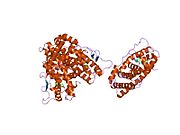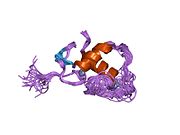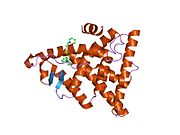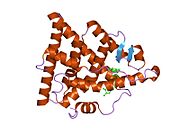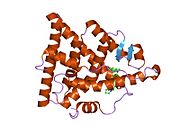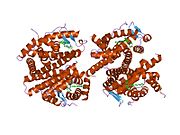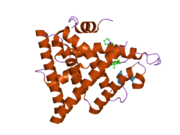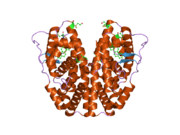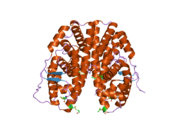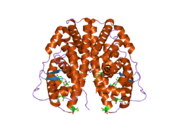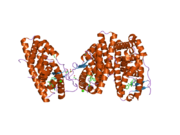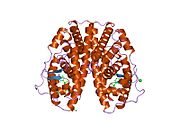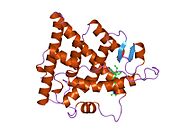Estrogen receptor alpha
Estrogen receptor alpha (ERα), also known as NR3A1 (nuclear receptor subfamily 3, group A, member 1), is one of two main types of estrogen receptor, a nuclear receptor (mainly found as a chromatin-binding protein[5]) that is activated by the sex hormone estrogen. In humans, ERα is encoded by the gene ESR1 (EStrogen Receptor 1).[6][7][8]
Structure
[edit]The estrogen receptor (ER) is a ligand-activated transcription factor composed of several domains important for hormone binding, DNA binding, and activation of transcription.[9] Alternative splicing results in several ESR1 mRNA transcripts, which differ primarily in their 5-prime untranslated regions. The translated receptors show less variability.[10][11]
Ligands
[edit]Agonists
[edit]Non-selective
[edit]- Endogenous estrogens (e.g., estradiol, estrone, estriol, estetrol)
- Natural estrogens (e.g., conjugated equine estrogens)
- Synthetic estrogens (e.g., ethinylestradiol, diethylstilbestrol)
Selective
[edit]Agonists of ERα selective over ERβ include:
- Propylpyrazoletriol (PPT)
- 16α-LE2 (Cpd1471)
- 16α-IE2
- ERA-63 (ORG-37663)
- SKF-82,958 – also a D1-like receptor full agonist
- (R,R)-Tetrahydrochrysene ((R,R)-THC) – actually not selective over ERβ, but rather an antagonist instead of an agonist of ERβ
Mixed
[edit]- Phytoestrogens (e.g., coumestrol, daidzein, genistein, miroestrol)
- Selective estrogen receptor modulators (e.g., tamoxifen, clomifene, raloxifene)
Antagonists
[edit]Non-selective
[edit]- Antiestrogens (e.g., fulvestrant, ICI-164384, ethamoxytriphetol)
Selective
[edit]Antagonists of ERα selective over ERβ include:
- Methylpiperidinopyrazole (MPP)
Affinities
[edit]| Ligand | Other names | Relative binding affinities (RBA, %)a | Absolute binding affinities (Ki, nM)a | Action | ||
|---|---|---|---|---|---|---|
| ERα | ERβ | ERα | ERβ | |||
| Estradiol | E2; 17β-Estradiol | 100 | 100 | 0.115 (0.04–0.24) | 0.15 (0.10–2.08) | Estrogen |
| Estrone | E1; 17-Ketoestradiol | 16.39 (0.7–60) | 6.5 (1.36–52) | 0.445 (0.3–1.01) | 1.75 (0.35–9.24) | Estrogen |
| Estriol | E3; 16α-OH-17β-E2 | 12.65 (4.03–56) | 26 (14.0–44.6) | 0.45 (0.35–1.4) | 0.7 (0.63–0.7) | Estrogen |
| Estetrol | E4; 15α,16α-Di-OH-17β-E2 | 4.0 | 3.0 | 4.9 | 19 | Estrogen |
| Alfatradiol | 17α-Estradiol | 20.5 (7–80.1) | 8.195 (2–42) | 0.2–0.52 | 0.43–1.2 | Metabolite |
| 16-Epiestriol | 16β-Hydroxy-17β-estradiol | 7.795 (4.94–63) | 50 | ? | ? | Metabolite |
| 17-Epiestriol | 16α-Hydroxy-17α-estradiol | 55.45 (29–103) | 79–80 | ? | ? | Metabolite |
| 16,17-Epiestriol | 16β-Hydroxy-17α-estradiol | 1.0 | 13 | ? | ? | Metabolite |
| 2-Hydroxyestradiol | 2-OH-E2 | 22 (7–81) | 11–35 | 2.5 | 1.3 | Metabolite |
| 2-Methoxyestradiol | 2-MeO-E2 | 0.0027–2.0 | 1.0 | ? | ? | Metabolite |
| 4-Hydroxyestradiol | 4-OH-E2 | 13 (8–70) | 7–56 | 1.0 | 1.9 | Metabolite |
| 4-Methoxyestradiol | 4-MeO-E2 | 2.0 | 1.0 | ? | ? | Metabolite |
| 2-Hydroxyestrone | 2-OH-E1 | 2.0–4.0 | 0.2–0.4 | ? | ? | Metabolite |
| 2-Methoxyestrone | 2-MeO-E1 | <0.001–<1 | <1 | ? | ? | Metabolite |
| 4-Hydroxyestrone | 4-OH-E1 | 1.0–2.0 | 1.0 | ? | ? | Metabolite |
| 4-Methoxyestrone | 4-MeO-E1 | <1 | <1 | ? | ? | Metabolite |
| 16α-Hydroxyestrone | 16α-OH-E1; 17-Ketoestriol | 2.0–6.5 | 35 | ? | ? | Metabolite |
| 2-Hydroxyestriol | 2-OH-E3 | 2.0 | 1.0 | ? | ? | Metabolite |
| 4-Methoxyestriol | 4-MeO-E3 | 1.0 | 1.0 | ? | ? | Metabolite |
| Estradiol sulfate | E2S; Estradiol 3-sulfate | <1 | <1 | ? | ? | Metabolite |
| Estradiol disulfate | Estradiol 3,17β-disulfate | 0.0004 | ? | ? | ? | Metabolite |
| Estradiol 3-glucuronide | E2-3G | 0.0079 | ? | ? | ? | Metabolite |
| Estradiol 17β-glucuronide | E2-17G | 0.0015 | ? | ? | ? | Metabolite |
| Estradiol 3-gluc. 17β-sulfate | E2-3G-17S | 0.0001 | ? | ? | ? | Metabolite |
| Estrone sulfate | E1S; Estrone 3-sulfate | <1 | <1 | >10 | >10 | Metabolite |
| Estradiol benzoate | EB; Estradiol 3-benzoate | 10 | ? | ? | ? | Estrogen |
| Estradiol 17β-benzoate | E2-17B | 11.3 | 32.6 | ? | ? | Estrogen |
| Estrone methyl ether | Estrone 3-methyl ether | 0.145 | ? | ? | ? | Estrogen |
| ent-Estradiol | 1-Estradiol | 1.31–12.34 | 9.44–80.07 | ? | ? | Estrogen |
| Equilin | 7-Dehydroestrone | 13 (4.0–28.9) | 13.0–49 | 0.79 | 0.36 | Estrogen |
| Equilenin | 6,8-Didehydroestrone | 2.0–15 | 7.0–20 | 0.64 | 0.62 | Estrogen |
| 17β-Dihydroequilin | 7-Dehydro-17β-estradiol | 7.9–113 | 7.9–108 | 0.09 | 0.17 | Estrogen |
| 17α-Dihydroequilin | 7-Dehydro-17α-estradiol | 18.6 (18–41) | 14–32 | 0.24 | 0.57 | Estrogen |
| 17β-Dihydroequilenin | 6,8-Didehydro-17β-estradiol | 35–68 | 90–100 | 0.15 | 0.20 | Estrogen |
| 17α-Dihydroequilenin | 6,8-Didehydro-17α-estradiol | 20 | 49 | 0.50 | 0.37 | Estrogen |
| Δ8-Estradiol | 8,9-Dehydro-17β-estradiol | 68 | 72 | 0.15 | 0.25 | Estrogen |
| Δ8-Estrone | 8,9-Dehydroestrone | 19 | 32 | 0.52 | 0.57 | Estrogen |
| Ethinylestradiol | EE; 17α-Ethynyl-17β-E2 | 120.9 (68.8–480) | 44.4 (2.0–144) | 0.02–0.05 | 0.29–0.81 | Estrogen |
| Mestranol | EE 3-methyl ether | ? | 2.5 | ? | ? | Estrogen |
| Moxestrol | RU-2858; 11β-Methoxy-EE | 35–43 | 5–20 | 0.5 | 2.6 | Estrogen |
| Methylestradiol | 17α-Methyl-17β-estradiol | 70 | 44 | ? | ? | Estrogen |
| Diethylstilbestrol | DES; Stilbestrol | 129.5 (89.1–468) | 219.63 (61.2–295) | 0.04 | 0.05 | Estrogen |
| Hexestrol | Dihydrodiethylstilbestrol | 153.6 (31–302) | 60–234 | 0.06 | 0.06 | Estrogen |
| Dienestrol | Dehydrostilbestrol | 37 (20.4–223) | 56–404 | 0.05 | 0.03 | Estrogen |
| Benzestrol (B2) | – | 114 | ? | ? | ? | Estrogen |
| Chlorotrianisene | TACE | 1.74 | ? | 15.30 | ? | Estrogen |
| Triphenylethylene | TPE | 0.074 | ? | ? | ? | Estrogen |
| Triphenylbromoethylene | TPBE | 2.69 | ? | ? | ? | Estrogen |
| Tamoxifen | ICI-46,474 | 3 (0.1–47) | 3.33 (0.28–6) | 3.4–9.69 | 2.5 | SERM |
| Afimoxifene | 4-Hydroxytamoxifen; 4-OHT | 100.1 (1.7–257) | 10 (0.98–339) | 2.3 (0.1–3.61) | 0.04–4.8 | SERM |
| Toremifene | 4-Chlorotamoxifen; 4-CT | ? | ? | 7.14–20.3 | 15.4 | SERM |
| Clomifene | MRL-41 | 25 (19.2–37.2) | 12 | 0.9 | 1.2 | SERM |
| Cyclofenil | F-6066; Sexovid | 151–152 | 243 | ? | ? | SERM |
| Nafoxidine | U-11,000A | 30.9–44 | 16 | 0.3 | 0.8 | SERM |
| Raloxifene | – | 41.2 (7.8–69) | 5.34 (0.54–16) | 0.188–0.52 | 20.2 | SERM |
| Arzoxifene | LY-353,381 | ? | ? | 0.179 | ? | SERM |
| Lasofoxifene | CP-336,156 | 10.2–166 | 19.0 | 0.229 | ? | SERM |
| Ormeloxifene | Centchroman | ? | ? | 0.313 | ? | SERM |
| Levormeloxifene | 6720-CDRI; NNC-460,020 | 1.55 | 1.88 | ? | ? | SERM |
| Ospemifene | Deaminohydroxytoremifene | 0.82–2.63 | 0.59–1.22 | ? | ? | SERM |
| Bazedoxifene | – | ? | ? | 0.053 | ? | SERM |
| Etacstil | GW-5638 | 4.30 | 11.5 | ? | ? | SERM |
| ICI-164,384 | – | 63.5 (3.70–97.7) | 166 | 0.2 | 0.08 | Antiestrogen |
| Fulvestrant | ICI-182,780 | 43.5 (9.4–325) | 21.65 (2.05–40.5) | 0.42 | 1.3 | Antiestrogen |
| Propylpyrazoletriol | PPT | 49 (10.0–89.1) | 0.12 | 0.40 | 92.8 | ERα agonist |
| 16α-LE2 | 16α-Lactone-17β-estradiol | 14.6–57 | 0.089 | 0.27 | 131 | ERα agonist |
| 16α-Iodo-E2 | 16α-Iodo-17β-estradiol | 30.2 | 2.30 | ? | ? | ERα agonist |
| Methylpiperidinopyrazole | MPP | 11 | 0.05 | ? | ? | ERα antagonist |
| Diarylpropionitrile | DPN | 0.12–0.25 | 6.6–18 | 32.4 | 1.7 | ERβ agonist |
| 8β-VE2 | 8β-Vinyl-17β-estradiol | 0.35 | 22.0–83 | 12.9 | 0.50 | ERβ agonist |
| Prinaberel | ERB-041; WAY-202,041 | 0.27 | 67–72 | ? | ? | ERβ agonist |
| ERB-196 | WAY-202,196 | ? | 180 | ? | ? | ERβ agonist |
| Erteberel | SERBA-1; LY-500,307 | ? | ? | 2.68 | 0.19 | ERβ agonist |
| SERBA-2 | – | ? | ? | 14.5 | 1.54 | ERβ agonist |
| Coumestrol | – | 9.225 (0.0117–94) | 64.125 (0.41–185) | 0.14–80.0 | 0.07–27.0 | Xenoestrogen |
| Genistein | – | 0.445 (0.0012–16) | 33.42 (0.86–87) | 2.6–126 | 0.3–12.8 | Xenoestrogen |
| Equol | – | 0.2–0.287 | 0.85 (0.10–2.85) | ? | ? | Xenoestrogen |
| Daidzein | – | 0.07 (0.0018–9.3) | 0.7865 (0.04–17.1) | 2.0 | 85.3 | Xenoestrogen |
| Biochanin A | – | 0.04 (0.022–0.15) | 0.6225 (0.010–1.2) | 174 | 8.9 | Xenoestrogen |
| Kaempferol | – | 0.07 (0.029–0.10) | 2.2 (0.002–3.00) | ? | ? | Xenoestrogen |
| Naringenin | – | 0.0054 (<0.001–0.01) | 0.15 (0.11–0.33) | ? | ? | Xenoestrogen |
| 8-Prenylnaringenin | 8-PN | 4.4 | ? | ? | ? | Xenoestrogen |
| Quercetin | – | <0.001–0.01 | 0.002–0.040 | ? | ? | Xenoestrogen |
| Ipriflavone | – | <0.01 | <0.01 | ? | ? | Xenoestrogen |
| Miroestrol | – | 0.39 | ? | ? | ? | Xenoestrogen |
| Deoxymiroestrol | – | 2.0 | ? | ? | ? | Xenoestrogen |
| β-Sitosterol | – | <0.001–0.0875 | <0.001–0.016 | ? | ? | Xenoestrogen |
| Resveratrol | – | <0.001–0.0032 | ? | ? | ? | Xenoestrogen |
| α-Zearalenol | – | 48 (13–52.5) | ? | ? | ? | Xenoestrogen |
| β-Zearalenol | – | 0.6 (0.032–13) | ? | ? | ? | Xenoestrogen |
| Zeranol | α-Zearalanol | 48–111 | ? | ? | ? | Xenoestrogen |
| Taleranol | β-Zearalanol | 16 (13–17.8) | 14 | 0.8 | 0.9 | Xenoestrogen |
| Zearalenone | ZEN | 7.68 (2.04–28) | 9.45 (2.43–31.5) | ? | ? | Xenoestrogen |
| Zearalanone | ZAN | 0.51 | ? | ? | ? | Xenoestrogen |
| Bisphenol A | BPA | 0.0315 (0.008–1.0) | 0.135 (0.002–4.23) | 195 | 35 | Xenoestrogen |
| Endosulfan | EDS | <0.001–<0.01 | <0.01 | ? | ? | Xenoestrogen |
| Kepone | Chlordecone | 0.0069–0.2 | ? | ? | ? | Xenoestrogen |
| o,p'-DDT | – | 0.0073–0.4 | ? | ? | ? | Xenoestrogen |
| p,p'-DDT | – | 0.03 | ? | ? | ? | Xenoestrogen |
| Methoxychlor | p,p'-Dimethoxy-DDT | 0.01 (<0.001–0.02) | 0.01–0.13 | ? | ? | Xenoestrogen |
| HPTE | Hydroxychlor; p,p'-OH-DDT | 1.2–1.7 | ? | ? | ? | Xenoestrogen |
| Testosterone | T; 4-Androstenolone | <0.0001–<0.01 | <0.002–0.040 | >5000 | >5000 | Androgen |
| Dihydrotestosterone | DHT; 5α-Androstanolone | 0.01 (<0.001–0.05) | 0.0059–0.17 | 221–>5000 | 73–1688 | Androgen |
| Nandrolone | 19-Nortestosterone; 19-NT | 0.01 | 0.23 | 765 | 53 | Androgen |
| Dehydroepiandrosterone | DHEA; Prasterone | 0.038 (<0.001–0.04) | 0.019–0.07 | 245–1053 | 163–515 | Androgen |
| 5-Androstenediol | A5; Androstenediol | 6 | 17 | 3.6 | 0.9 | Androgen |
| 4-Androstenediol | – | 0.5 | 0.6 | 23 | 19 | Androgen |
| 4-Androstenedione | A4; Androstenedione | <0.01 | <0.01 | >10000 | >10000 | Androgen |
| 3α-Androstanediol | 3α-Adiol | 0.07 | 0.3 | 260 | 48 | Androgen |
| 3β-Androstanediol | 3β-Adiol | 3 | 7 | 6 | 2 | Androgen |
| Androstanedione | 5α-Androstanedione | <0.01 | <0.01 | >10000 | >10000 | Androgen |
| Etiocholanedione | 5β-Androstanedione | <0.01 | <0.01 | >10000 | >10000 | Androgen |
| Methyltestosterone | 17α-Methyltestosterone | <0.0001 | ? | ? | ? | Androgen |
| Ethinyl-3α-androstanediol | 17α-Ethynyl-3α-adiol | 4.0 | <0.07 | ? | ? | Estrogen |
| Ethinyl-3β-androstanediol | 17α-Ethynyl-3β-adiol | 50 | 5.6 | ? | ? | Estrogen |
| Progesterone | P4; 4-Pregnenedione | <0.001–0.6 | <0.001–0.010 | ? | ? | Progestogen |
| Norethisterone | NET; 17α-Ethynyl-19-NT | 0.085 (0.0015–<0.1) | 0.1 (0.01–0.3) | 152 | 1084 | Progestogen |
| Norethynodrel | 5(10)-Norethisterone | 0.5 (0.3–0.7) | <0.1–0.22 | 14 | 53 | Progestogen |
| Tibolone | 7α-Methylnorethynodrel | 0.5 (0.45–2.0) | 0.2–0.076 | ? | ? | Progestogen |
| Δ4-Tibolone | 7α-Methylnorethisterone | 0.069–<0.1 | 0.027–<0.1 | ? | ? | Progestogen |
| 3α-Hydroxytibolone | – | 2.5 (1.06–5.0) | 0.6–0.8 | ? | ? | Progestogen |
| 3β-Hydroxytibolone | – | 1.6 (0.75–1.9) | 0.070–0.1 | ? | ? | Progestogen |
| Footnotes: a = (1) Binding affinity values are of the format "median (range)" (# (#–#)), "range" (#–#), or "value" (#) depending on the values available. The full sets of values within the ranges can be found in the Wiki code. (2) Binding affinities were determined via displacement studies in a variety of in-vitro systems with labeled estradiol and human ERα and ERβ proteins (except the ERβ values from Kuiper et al. (1997), which are rat ERβ). Sources: See template page. | ||||||
Tissue distribution and function
[edit]ERα plays a role in the physiological development and function of a variety of organ systems to varying degrees, including the reproductive, central nervous, skeletal, and cardiovascular systems.[12] Accordingly, ERα is widely expressed throughout the body, including the uterus and ovary, male reproductive organs, mammary gland, bone, heart, hypothalamus, pituitary gland, liver, lung, kidney, spleen, and adipose tissue.[12][13][14] The development and function of these tissues is disrupted in animal models lacking active ERα genes, such as the ERα knockout mouse (ERKO), providing a preliminary understanding of ERα function at specific target organs.[12][15]
Uterus and ovary
[edit]ERα is essential in the maturation of the female reproductive phenotype. In the absence of ERα, the ERKO mouse develops an adult uterus, indicating that ERα may not mediate the initial growth of the uterus.[12][13] However, ERα plays a role in the completion of this development, and the subsequent function of the tissue.[15] Activation of ERα is known to trigger cell proliferation in the uterus.[14] The uterus of female ERKO mice is hypoplastic, suggesting that ERα mediates mitosis and differentiation in the uterus in response to estrogen stimulation.[13]
Similarly, prepubertal female ERKO mice develop ovaries that are nearly indistinguishable from those of their wildtype counterparts. However, as the ERKO mice mature they progressively present an abnormal ovarian phenotype in both physiology and function.[13][15] Specifically, female ERKO mice develop enlarged ovaries containing hemorrhagic follicular cysts, which also lack the corpus luteum, and therefore do not ovulate.[12][13][15] This adult ovarian phenotype suggests that in the absence of ERα, estrogen is no longer able to perform negative feedback on the hypothalamus, resulting in chronically elevated LH levels and constant ovarian stimulation.[13] These results identify a pivotal role for ERα in the hypothalamus, in addition to its role in the estrogen-driven maturation through theca and interstitial cells of the ovary.[13]
Male reproductive organs
[edit]ERα is similarly essential in the maturation and maintenance of the male reproductive phenotype, as male ERKO mice are infertile and present undersized testes.[12][15] The integrity of testicular structures of ERKO mice, such as the seminiferous tubules of the testes and the seminiferous epithelium, declines over time.[12][13] Furthermore, the reproductive performance of male ERKO mice is hindered by abnormalities in sexual physiology and behavior, such as impaired spermatogenesis and loss of intromission and ejaculatory responses.[12][13]
Mammary gland
[edit]Estrogen stimulation of ERα is known to stimulate cell proliferation in breast tissue.[14] ERα is thought to be responsible for pubertal development of the adult phenotype, through mediation of mammary gland response to estrogens.[15] This role is consistent with the abnormalities of female ERKO mice: the epithelial ducts of female ERKO mice fail to grow beyond their pre-pubertal length, and lactational structures do not develop.[13] As a result, the functions of the mammary gland—including both lactation and release of prolactin—are greatly impaired in ERKO mice.[15]
Bone
[edit]Though its expression in bone is moderate, ERα is known to be responsible for maintenance of bone integrity.[14][15] It is hypothesized that estrogen stimulation of ERα may trigger the release of growth factors, such as epidermal growth factor or insulin-like growth factor-1, which in turn regulate bone development and maintenance.[15][13] Accordingly, male and female ERKO mice exhibit decreased bone length and size.[15][13]
Brain
[edit]Estrogen signaling through ERα appears to be responsible for various aspects of central nervous development, such as synaptogenesis and synaptic remodeling.[15] In the brain, ERα is found in hypothalamus, and preoptic area, and arcuate nucleus, all three of which have been linked to reproductive behavior, and the masculinization of the mouse brain appears to take place through ERα function.[12][15] Furthermore, studies in models of psychopathology and neurodegenerative disease states suggest that estrogen receptors mediate the neuroprotective role of estrogen in the brain.[12][14] Finally, ERα appears to mediate positive feedback effects of estrogen on the brain's secretion of GnRH and LH, by way increasing expression of kisspeptin in neurons of the arcuate nucleus and anteroventral periventricular nucleus.[16][17] Although classical studies have suggested that negative feedback effects of estrogen also operate through ERα, female mice lacking ERα in kisspeptin-expressing neurons continue to demonstrate a degree of negative feedback response.[18]
Clinical significance
[edit]Estrogen insensitivity syndrome is a very rare condition characterized by a defective ERα that is insensitive to estrogens.[19][20][21][22] The clinical presentation of a female was observed to include absence of breast development and other female secondary sexual characteristics at puberty, hypoplastic uterus, primary amenorrhea, enlarged multicystic ovaries and associated lower abdominal pain, mild hyperandrogenism (manifested as cystic acne), and delayed bone maturation as well as an increased rate of bone turnover.[22] The clinical presentation in a male was reported to include lack of epiphyseal closure, tall stature, osteoporosis, and poor sperm viability.[21] Both individuals were completely insensitive to exogenous estrogen treatment, even with high doses.[21][22]
Genetic polymorphisms in the gene encoding the ERα have been associated with breast cancer in women, gynecomastia in men[23][24] and dysmenorrhea.[25]
In patients with breast cancer, mutations in the gene encoding ERα (ESR1) have been associated with resistance to endocrine therapy, especially aromatase inhibitors.[26]
Coactivators
[edit]Coactivators of ER-α include:
- SRC-1[27][28]
- AIB1 – amplified in breast 1[29]
- PELP-1 – Proline-, glutamic acid-, leucine-rich protein 1[30]
Interactions
[edit]Estrogen receptor alpha has been shown to interact with:
- AKAP13[31]
- AHR[32][33]
- BRCA1[34][35][36][37]
- CAV1[38]
- CCNC[39]
- CDC25B[40]
- CEBPB[41][42]
- COBRA1[43]
- COUP-TFI[44]
- CREBBP[37][45]
- CRSP3[39]
- Cyclin D1[46]
- DNTTIP2[47]
- EP300[37][39][48]
- ESR2[49][50]
- FOXO1[51]
- GREB1[52]
- GTF2H1[53]
- HSPA1A[54]
- HSPA8[54]
- HSP90AA1[55][56]
- ISL1[57]
- JARID1A[58]
- MVP[59]
- MED1[39]
- MED12[39]
- MED14[39]
- MED16[39]
- MED24[39]
- MED6[39]
- MGMT[60]
- MNAT1[61]
- MTA1[62][63]
- NCOA6[64][65]
- NCOA1[39][45][66][67]
- NCOA2[68][69][70]
- NCOA3[71][72]
- NRIP1[73][74][75]
- PDLIM1[76]
- POU4F1[77]
- POU4F2[77]
- PRDM2[78]
- PRMT2[79]
- RBM39[80]
- RNF12[76]
- SAFB[81][82]
- SAFB2[83]
- SHC1[84]
- SHP[85][86]
- SMARCA4[66][87]
- SMARCE1[88]
- Src[60][89][90][91]
- TR2[92]
- TR4[93]
- TDG[94]
- TRIM24[74][95] and
- XBP1.[96]
References
[edit]- ^ a b c GRCh38: Ensembl release 89: ENSG00000091831 – Ensembl, May 2017
- ^ a b c GRCm38: Ensembl release 89: ENSMUSG00000019768 – Ensembl, May 2017
- ^ "Human PubMed Reference:". National Center for Biotechnology Information, U.S. National Library of Medicine.
- ^ "Mouse PubMed Reference:". National Center for Biotechnology Information, U.S. National Library of Medicine.
- ^ Dhamad AE, Zhou Z, Zhou J, Du Y (2016-08-02). Picard D (ed.). "Systematic Proteomic Identification of the Heat Shock Proteins (Hsp) that Interact with Estrogen Receptor Alpha (ERα) and Biochemical Characterization of the ERα-Hsp70 Interaction". PLOS ONE. 11 (8): e0160312. Bibcode:2016PLoSO..1160312D. doi:10.1371/journal.pone.0160312. PMC 4970746. PMID 27483141.
- ^ "Entrez Gene: ESR1 estrogen receptor 1".
- ^ Walter P, Green S, Greene G, Krust A, Bornert JM, Jeltsch JM, et al. (December 1985). "Cloning of the human estrogen receptor cDNA". Proceedings of the National Academy of Sciences of the United States of America. 82 (23): 7889–7893. Bibcode:1985PNAS...82.7889W. doi:10.1073/pnas.82.23.7889. PMC 390875. PMID 3865204.
- ^ Greene GL, Gilna P, Waterfield M, Baker A, Hort Y, Shine J (March 1986). "Sequence and expression of human estrogen receptor complementary DNA". Science. 231 (4742): 1150–1154. Bibcode:1986Sci...231.1150G. doi:10.1126/science.3753802. PMID 3753802.
- ^ Dahlman-Wright K, Cavailles V, Fuqua SA, Jordan VC, Katzenellenbogen JA, Korach KS, et al. (December 2006). "International Union of Pharmacology. LXIV. Estrogen receptors". Pharmacological Reviews. 58 (4): 773–781. doi:10.1124/pr.58.4.8. PMID 17132854. S2CID 45996586.
- ^ "Entrez Gene: DBI diazepam binding inhibitor (GABA receptor modulator, acyl-Coenzyme A binding protein)".
- ^ Kos M, Reid G, Denger S, Gannon F (December 2001). "Minireview: genomic organization of the human ERalpha gene promoter region". Molecular Endocrinology. 15 (12): 2057–2063. doi:10.1210/mend.15.12.0731. PMID 11731608.
- ^ a b c d e f g h i j Bondesson M, Hao R, Lin CY, Williams C, Gustafsson JÅ (February 2015). "Estrogen receptor signaling during vertebrate development". Biochimica et Biophysica Acta (BBA) - Gene Regulatory Mechanisms. 1849 (2): 142–151. doi:10.1016/j.bbagrm.2014.06.005. PMC 4269570. PMID 24954179.
- ^ a b c d e f g h i j k l Curtis Hewitt S, Couse JF, Korach KS (2000). "Estrogen receptor transcription and transactivation: Estrogen receptor knockout mice: what their phenotypes reveal about mechanisms of estrogen action". Breast Cancer Research. 2 (5): 345–352. doi:10.1186/bcr79. PMC 138656. PMID 11250727.
- ^ a b c d e Paterni I, Granchi C, Katzenellenbogen JA, Minutolo F (November 2014). "Estrogen receptors alpha (ERα) and beta (ERβ): subtype-selective ligands and clinical potential". Steroids. 90: 13–29. doi:10.1016/j.steroids.2014.06.012. PMC 4192010. PMID 24971815.
- ^ a b c d e f g h i j k l Lee HR, Kim TH, Choi KC (June 2012). "Functions and physiological roles of two types of estrogen receptors, ERα and ERβ, identified by estrogen receptor knockout mouse". Laboratory Animal Research. 28 (2): 71–76. doi:10.5625/lar.2012.28.2.71. PMC 3389841. PMID 22787479.
- ^ Clarkson J (April 2013). "Effects of estradiol on kisspeptin neurons during puberty". Frontiers in Neuroendocrinology. 34 (2): 120–131. doi:10.1016/j.yfrne.2013.02.002. PMID 23500175. S2CID 26118271.
- ^ Moenter SM, Chu Z, Christian CA (March 2009). "Neurobiological mechanisms underlying oestradiol negative and positive feedback regulation of gonadotrophin-releasing hormone neurones". Journal of Neuroendocrinology. 21 (4): 327–333. doi:10.1111/j.1365-2826.2009.01826.x. PMC 2738426. PMID 19207821.
- ^ Plant TM (August 2015). "60 YEARS OF NEUROENDOCRINOLOGY: The hypothalamo-pituitary-gonadal axis". The Journal of Endocrinology. 226 (2): T41–T54. doi:10.1530/JOE-15-0113. PMC 4498991. PMID 25901041.
- ^ Jameson JL, De Groot LJ (February 2015). Endocrinology: Adult and Pediatric. Elsevier Health Sciences. pp. 238–. ISBN 978-0-323-32195-2.
- ^ Korach KS, Couse JF, Curtis SW, Washburn TF, Lindzey J, Kimbro KS, et al. (1996). "Estrogen receptor gene disruption: molecular characterization and experimental and clinical phenotypes". Recent Progress in Hormone Research. 51: 159–86, discussion 186–8. PMID 8701078.
- ^ a b c Smith EP, Boyd J, Frank GR, Takahashi H, Cohen RM, Specker B, et al. (October 1994). "Estrogen resistance caused by a mutation in the estrogen-receptor gene in a man". The New England Journal of Medicine. 331 (16): 1056–1061. doi:10.1056/NEJM199410203311604. PMID 8090165.
- ^ a b c Quaynor SD, Stradtman EW, Kim HG, Shen Y, Chorich LP, Schreihofer DA, et al. (July 2013). "Delayed puberty and estrogen resistance in a woman with estrogen receptor α variant". The New England Journal of Medicine. 369 (2): 164–171. doi:10.1056/NEJMoa1303611. PMC 3823379. PMID 23841731.
- ^ Jahandoost S, Farhanghian P, Abbasi S (2017). "The Effects of Sex Protein Receptors and Sex Steroid Hormone Gene Polymorphisms on Breast Cancer Risk". Journal of the National Medical Association. 109 (2): 126–138. doi:10.1016/j.jnma.2017.02.003. PMID 28599754.
- ^ Eren E, Edgunlu T, Korkmaz HA, Cakir ED, Demir K, Cetin ES, et al. (May 2014). "Genetic variants of estrogen beta and leptin receptors may cause gynecomastia in adolescent". Gene. 541 (2): 101–106. doi:10.1016/j.gene.2014.03.013. PMID 24625355.
- ^ Woo HY, Kim KH, Lim SW (February 2010). "Estrogen receptor 1, glutathione S-transferase P1, glutathione S-transferase M1, and glutathione S-transferase T1 genes with dysmenorrhea in Korean female adolescents". The Korean Journal of Laboratory Medicine. 30 (1): 76–83. doi:10.3343/kjlm.2010.30.1.76. PMID 20197727.
- ^ Henry NL, Somerfield MR, Dayao Z, Elias A, Kalinsky K, McShane LM, et al. (September 2022). "Biomarkers for Systemic Therapy in Metastatic Breast Cancer: ASCO Guideline Update". Journal of Clinical Oncology. 40 (27): 3205–3221. doi:10.1200/JCO.22.01063. PMID 35759724.
- ^ Shang Y, Brown M (March 2002). "Molecular determinants for the tissue specificity of SERMs". Science. 295 (5564): 2465–2468. Bibcode:2002Sci...295.2465S. doi:10.1126/science.1068537. PMID 11923541. S2CID 30634073.
- ^ Smith CL, O'Malley BW (February 2004). "Coregulator function: a key to understanding tissue specificity of selective receptor modulators". Endocrine Reviews. 25 (1): 45–71. doi:10.1210/er.2003-0023. PMID 14769827.
- ^ Anzick SL, Kononen J, Walker RL, Azorsa DO, Tanner MM, Guan XY, et al. (August 1997). "AIB1, a steroid receptor coactivator amplified in breast and ovarian cancer". Science. 277 (5328): 965–968. doi:10.1126/science.277.5328.965. PMID 9252329.
- ^ Vadlamudi RK, Wang RA, Mazumdar A, Kim Y, Shin J, Sahin A, et al. (October 2001). "Molecular cloning and characterization of PELP1, a novel human coregulator of estrogen receptor alpha". The Journal of Biological Chemistry. 276 (41): 38272–38279. doi:10.1074/jbc.M103783200. PMID 11481323.
- ^ Rubino D, Driggers P, Arbit D, Kemp L, Miller B, Coso O, et al. (May 1998). "Characterization of Brx, a novel Dbl family member that modulates estrogen receptor action". Oncogene. 16 (19): 2513–2526. doi:10.1038/sj.onc.1201783. PMID 9627117. S2CID 20906586.
- ^ Wormke M, Stoner M, Saville B, Walker K, Abdelrahim M, Burghardt R, et al. (March 2003). "The aryl hydrocarbon receptor mediates degradation of estrogen receptor alpha through activation of proteasomes". Molecular and Cellular Biology. 23 (6): 1843–1855. doi:10.1128/MCB.23.6.1843-1855.2003. PMC 149455. PMID 12612060.
- ^ Klinge CM, Kaur K, Swanson HI (January 2000). "The aryl hydrocarbon receptor interacts with estrogen receptor alpha and orphan receptors COUP-TFI and ERRalpha1". Archives of Biochemistry and Biophysics. 373 (1): 163–174. doi:10.1006/abbi.1999.1552. PMID 10620335.
- ^ Zheng L, Annab LA, Afshari CA, Lee WH, Boyer TG (August 2001). "BRCA1 mediates ligand-independent transcriptional repression of the estrogen receptor". Proceedings of the National Academy of Sciences of the United States of America. 98 (17): 9587–9592. Bibcode:2001PNAS...98.9587Z. doi:10.1073/pnas.171174298. PMC 55496. PMID 11493692.
- ^ Fan S, Ma YX, Wang C, Yuan RQ, Meng Q, Wang JA, et al. (January 2001). "Role of direct interaction in BRCA1 inhibition of estrogen receptor activity". Oncogene. 20 (1): 77–87. doi:10.1038/sj.onc.1204073. PMID 11244506. S2CID 24657209.
- ^ Kawai H, Li H, Chun P, Avraham S, Avraham HK (October 2002). "Direct interaction between BRCA1 and the estrogen receptor regulates vascular endothelial growth factor (VEGF) transcription and secretion in breast cancer cells". Oncogene. 21 (50): 7730–7739. doi:10.1038/sj.onc.1205971. PMID 12400015. S2CID 32740995.
- ^ a b c Fan S, Ma YX, Wang C, Yuan RQ, Meng Q, Wang JA, et al. (January 2002). "p300 Modulates the BRCA1 inhibition of estrogen receptor activity". Cancer Research. 62 (1): 141–151. PMID 11782371.
- ^ Schlegel A, Wang C, Pestell RG, Lisanti MP (October 2001). "Ligand-independent activation of oestrogen receptor alpha by caveolin-1". The Biochemical Journal. 359 (Pt 1): 203–210. doi:10.1042/0264-6021:3590203. PMC 1222136. PMID 11563984.
- ^ a b c d e f g h i j Kang YK, Guermah M, Yuan CX, Roeder RG (March 2002). "The TRAP/Mediator coactivator complex interacts directly with estrogen receptors alpha and beta through the TRAP220 subunit and directly enhances estrogen receptor function in vitro". Proceedings of the National Academy of Sciences of the United States of America. 99 (5): 2642–2647. Bibcode:2002PNAS...99.2642K. doi:10.1073/pnas.261715899. PMC 122401. PMID 11867769.
- ^ Ma ZQ, Liu Z, Ngan ES, Tsai SY (December 2001). "Cdc25B functions as a novel coactivator for the steroid receptors". Molecular and Cellular Biology. 21 (23): 8056–8067. doi:10.1128/MCB.21.23.8056-8067.2001. PMC 99972. PMID 11689696.
- ^ Boruk M, Savory JG, Haché RJ (November 1998). "AF-2-dependent potentiation of CCAAT enhancer binding protein beta-mediated transcriptional activation by glucocorticoid receptor". Molecular Endocrinology. 12 (11): 1749–1763. doi:10.1210/mend.12.11.0191. PMID 9817600.
- ^ Stein B, Yang MX (September 1995). "Repression of the interleukin-6 promoter by estrogen receptor is mediated by NF-kappa B and C/EBP beta". Molecular and Cellular Biology. 15 (9): 4971–4979. doi:10.1128/MCB.15.9.4971. PMC 230744. PMID 7651415.
- ^ Aiyar SE, Sun JL, Blair AL, Moskaluk CA, Lu YZ, Ye QN, et al. (September 2004). "Attenuation of estrogen receptor alpha-mediated transcription through estrogen-stimulated recruitment of a negative elongation factor". Genes & Development. 18 (17): 2134–2146. doi:10.1101/gad.1214104. PMC 515291. PMID 15342491.
- ^ Métivier R, Gay FA, Hübner MR, Flouriot G, Salbert G, Gannon F, et al. (July 2002). "Formation of an hER alpha-COUP-TFI complex enhances hER alpha AF-1 through Ser118 phosphorylation by MAPK". The EMBO Journal. 21 (13): 3443–3453. doi:10.1093/emboj/cdf344. PMC 126093. PMID 12093745.
- ^ a b Sheppard HM, Harries JC, Hussain S, Bevan C, Heery DM (January 2001). "Analysis of the steroid receptor coactivator 1 (SRC1)-CREB binding protein interaction interface and its importance for the function of SRC1". Molecular and Cellular Biology. 21 (1): 39–50. doi:10.1128/MCB.21.1.39-50.2001. PMC 86566. PMID 11113179.
- ^ Zwijsen RM, Wientjens E, Klompmaker R, van der Sman J, Bernards R, Michalides RJ (February 1997). "CDK-independent activation of estrogen receptor by cyclin D1". Cell. 88 (3): 405–415. doi:10.1016/S0092-8674(00)81879-6. hdl:1874/21074. PMID 9039267. S2CID 16492666.
- ^ Bu H, Kashireddy P, Chang J, Zhu YT, Zhang Z, Zheng W, et al. (April 2004). "ERBP, a novel estrogen receptor binding protein enhancing the activity of estrogen receptor". Biochemical and Biophysical Research Communications. 317 (1): 54–59. doi:10.1016/j.bbrc.2004.02.179. PMID 15047147.
- ^ Fajas L, Egler V, Reiter R, Hansen J, Kristiansen K, Debril MB, et al. (December 2002). "The retinoblastoma-histone deacetylase 3 complex inhibits PPARgamma and adipocyte differentiation". Developmental Cell. 3 (6): 903–910. doi:10.1016/S1534-5807(02)00360-X. PMID 12479814.
- ^ Ogawa S, Inoue S, Watanabe T, Hiroi H, Orimo A, Hosoi T, et al. (February 1998). "The complete primary structure of human estrogen receptor beta (hER beta) and its heterodimerization with ER alpha in vivo and in vitro". Biochemical and Biophysical Research Communications. 243 (1): 122–126. doi:10.1006/bbrc.1997.7893. PMID 9473491.
- ^ Poelzl G, Kasai Y, Mochizuki N, Shaul PW, Brown M, Mendelsohn ME (March 2000). "Specific association of estrogen receptor beta with the cell cycle spindle assembly checkpoint protein, MAD2". Proceedings of the National Academy of Sciences of the United States of America. 97 (6): 2836–2839. Bibcode:2000PNAS...97.2836P. doi:10.1073/pnas.050580997. PMC 16016. PMID 10706629.
- ^ Schuur ER, Loktev AV, Sharma M, Sun Z, Roth RA, Weigel RJ (September 2001). "Ligand-dependent interaction of estrogen receptor-alpha with members of the forkhead transcription factor family". The Journal of Biological Chemistry. 276 (36): 33554–33560. doi:10.1074/jbc.M105555200. PMID 11435445. S2CID 11652289.
- ^ Deschênes J, Bourdeau V, White JH, Mader S (June 2007). "Regulation of GREB1 transcription by estrogen receptor alpha through a multipartite enhancer spread over 20 kb of upstream flanking sequences". The Journal of Biological Chemistry. 282 (24): 17335–17339. doi:10.1074/jbc.C700030200. PMID 17463000. S2CID 24262059.
- ^ Chen D, Riedl T, Washbrook E, Pace PE, Coombes RC, Egly JM, et al. (July 2000). "Activation of estrogen receptor alpha by S118 phosphorylation involves a ligand-dependent interaction with TFIIH and participation of CDK7". Molecular Cell. 6 (1): 127–137. doi:10.1016/S1097-2765(00)00014-9. PMID 10949034.
- ^ a b Dhamad AE, Zhou Z, Zhou J, Du Y (2016). "Systematic Proteomic Identification of the Heat Shock Proteins (Hsp) that Interact with Estrogen Receptor Alpha (ERα) and Biochemical Characterization of the ERα-Hsp70 Interaction". PLOS ONE. 11 (8): e0160312. Bibcode:2016PLoSO..1160312D. doi:10.1371/journal.pone.0160312. PMC 4970746. PMID 27483141.
- ^ Nair SC, Toran EJ, Rimerman RA, Hjermstad S, Smithgall TE, Smith DF (December 1996). "A pathway of multi-chaperone interactions common to diverse regulatory proteins: estrogen receptor, Fes tyrosine kinase, heat shock transcription factor Hsf1, and the aryl hydrocarbon receptor". Cell Stress & Chaperones. 1 (4): 237–250. doi:10.1379/1466-1268(1996)001<0237:APOMCI>2.3.CO;2 (inactive 2024-11-02). PMC 376461. PMID 9222609.
{{cite journal}}: CS1 maint: DOI inactive as of November 2024 (link) - ^ Lee MO, Kim EO, Kwon HJ, Kim YM, Kang HJ, Kang H, et al. (February 2002). "Radicicol represses the transcriptional function of the estrogen receptor by suppressing the stabilization of the receptor by heat shock protein 90". Molecular and Cellular Endocrinology. 188 (1–2): 47–54. doi:10.1016/S0303-7207(01)00753-5. PMID 11911945. S2CID 37933406.
- ^ Gay F, Anglade I, Gong Z, Salbert G (October 2000). "The LIM/homeodomain protein islet-1 modulates estrogen receptor functions". Molecular Endocrinology. 14 (10): 1627–1648. doi:10.1210/mend.14.10.0538. PMID 11043578.
- ^ Chan SW, Hong W (July 2001). "Retinoblastoma-binding protein 2 (Rbp2) potentiates nuclear hormone receptor-mediated transcription". The Journal of Biological Chemistry. 276 (30): 28402–28412. doi:10.1074/jbc.M100313200. PMID 11358960. S2CID 22993127.
- ^ Abbondanza C, Rossi V, Roscigno A, Gallo L, Belsito A, Piluso G, et al. (June 1998). "Interaction of vault particles with estrogen receptor in the MCF-7 breast cancer cell". The Journal of Cell Biology. 141 (6): 1301–1310. doi:10.1083/jcb.141.6.1301. PMC 2132791. PMID 9628887.
- ^ a b Teo AK, Oh HK, Ali RB, Li BF (October 2001). "The modified human DNA repair enzyme O(6)-methylguanine-DNA methyltransferase is a negative regulator of estrogen receptor-mediated transcription upon alkylation DNA damage". Molecular and Cellular Biology. 21 (20): 7105–7114. doi:10.1128/MCB.21.20.7105-7114.2001. PMC 99886. PMID 11564893.
- ^ Talukder AH, Mishra SK, Mandal M, Balasenthil S, Mehta S, Sahin AA, et al. (March 2003). "MTA1 interacts with MAT1, a cyclin-dependent kinase-activating kinase complex ring finger factor, and regulates estrogen receptor transactivation functions". The Journal of Biological Chemistry. 278 (13): 11676–11685. doi:10.1074/jbc.M209570200. PMID 12527756. S2CID 25527041.
- ^ Kumar R, Wang RA, Mazumdar A, Talukder AH, Mandal M, Yang Z, et al. (August 2002). "A naturally occurring MTA1 variant sequesters oestrogen receptor-alpha in the cytoplasm". Nature. 418 (6898): 654–657. Bibcode:2002Natur.418..654K. doi:10.1038/nature00889. PMID 12167865. S2CID 4355677.
- ^ Mazumdar A, Wang RA, Mishra SK, Adam L, Bagheri-Yarmand R, Mandal M, et al. (January 2001). "Transcriptional repression of oestrogen receptor by metastasis-associated protein 1 corepressor". Nature Cell Biology. 3 (1): 30–37. doi:10.1038/35050532. PMID 11146623. S2CID 23477845.
- ^ Lee SK, Anzick SL, Choi JE, Bubendorf L, Guan XY, Jung YK, et al. (November 1999). "A nuclear factor, ASC-2, as a cancer-amplified transcriptional coactivator essential for ligand-dependent transactivation by nuclear receptors in vivo". The Journal of Biological Chemistry. 274 (48): 34283–34293. doi:10.1074/jbc.274.48.34283. PMID 10567404. S2CID 36982011.
- ^ Ko L, Cardona GR, Iwasaki T, Bramlett KS, Burris TP, Chin WW (January 2002). "Ser-884 adjacent to the LXXLL motif of coactivator TRBP defines selectivity for ERs and TRs". Molecular Endocrinology. 16 (1): 128–140. doi:10.1210/mend.16.1.0755. PMID 11773444.
- ^ a b DiRenzo J, Shang Y, Phelan M, Sif S, Myers M, Kingston R, et al. (October 2000). "BRG-1 is recruited to estrogen-responsive promoters and cooperates with factors involved in histone acetylation". Molecular and Cellular Biology. 20 (20): 7541–7549. doi:10.1128/MCB.20.20.7541-7549.2000. PMC 86306. PMID 11003650.
- ^ Kalkhoven E, Valentine JE, Heery DM, Parker MG (January 1998). "Isoforms of steroid receptor co-activator 1 differ in their ability to potentiate transcription by the oestrogen receptor". The EMBO Journal. 17 (1): 232–243. doi:10.1093/emboj/17.1.232. PMC 1170374. PMID 9427757.
- ^ Wärnmark A, Treuter E, Gustafsson JA, Hubbard RE, Brzozowski AM, Pike AC (June 2002). "Interaction of transcriptional intermediary factor 2 nuclear receptor box peptides with the coactivator binding site of estrogen receptor alpha". The Journal of Biological Chemistry. 277 (24): 21862–21868. doi:10.1074/jbc.M200764200. PMID 11937504. S2CID 45251979.
- ^ He B, Wilson EM (March 2003). "Electrostatic modulation in steroid receptor recruitment of LXXLL and FXXLF motifs". Molecular and Cellular Biology. 23 (6): 2135–2150. doi:10.1128/MCB.23.6.2135-2150.2003. PMC 149467. PMID 12612084.
- ^ Fenne IS, Hoang T, Hauglid M, Sagen JV, Lien EA, Mellgren G (September 2008). "Recruitment of coactivator glucocorticoid receptor interacting protein 1 to an estrogen receptor transcription complex is regulated by the 3',5'-cyclic adenosine 5'-monophosphate-dependent protein kinase". Endocrinology. 149 (9): 4336–4345. doi:10.1210/en.2008-0037. PMID 18499756.
- ^ Wong CW, Komm B, Cheskis BJ (June 2001). "Structure-function evaluation of ER alpha and beta interplay with SRC family coactivators. ER selective ligands". Biochemistry. 40 (23): 6756–6765. doi:10.1021/bi010379h. PMID 11389589.
- ^ Tikkanen MK, Carter DJ, Harris AM, Le HM, Azorsa DO, Meltzer PS, et al. (November 2000). "Endogenously expressed estrogen receptor and coactivator AIB1 interact in MCF-7 human breast cancer cells". Proceedings of the National Academy of Sciences of the United States of America. 97 (23): 12536–12540. Bibcode:2000PNAS...9712536T. doi:10.1073/pnas.220427297. PMC 18799. PMID 11050174.
- ^ Cavaillès V, Dauvois S, L'Horset F, Lopez G, Hoare S, Kushner PJ, et al. (August 1995). "Nuclear factor RIP140 modulates transcriptional activation by the estrogen receptor". The EMBO Journal. 14 (15): 3741–3751. doi:10.1002/j.1460-2075.1995.tb00044.x. PMC 394449. PMID 7641693.
- ^ a b Thénot S, Henriquet C, Rochefort H, Cavaillès V (May 1997). "Differential interaction of nuclear receptors with the putative human transcriptional coactivator hTIF1". The Journal of Biological Chemistry. 272 (18): 12062–12068. doi:10.1074/jbc.272.18.12062. PMID 9115274. S2CID 32098587.
- ^ L'Horset F, Dauvois S, Heery DM, Cavaillès V, Parker MG (November 1996). "RIP-140 interacts with multiple nuclear receptors by means of two distinct sites". Molecular and Cellular Biology. 16 (11): 6029–6036. doi:10.1128/MCB.16.11.6029. PMC 231605. PMID 8887632.
- ^ a b Johnsen SA, Güngör C, Prenzel T, Riethdorf S, Riethdorf L, Taniguchi-Ishigaki N, et al. (January 2009). "Regulation of estrogen-dependent transcription by the LIM cofactors CLIM and RLIM in breast cancer". Cancer Research. 69 (1): 128–136. doi:10.1158/0008-5472.CAN-08-1630. PMC 2713826. PMID 19117995.
- ^ a b Budhram-Mahadeo V, Parker M, Latchman DS (February 1998). "POU transcription factors Brn-3a and Brn-3b interact with the estrogen receptor and differentially regulate transcriptional activity via an estrogen response element". Molecular and Cellular Biology. 18 (2): 1029–1041. doi:10.1128/mcb.18.2.1029. PMC 108815. PMID 9448000.
- ^ Abbondanza C, Medici N, Nigro V, Rossi V, Gallo L, Piluso G, et al. (March 2000). "The retinoblastoma-interacting zinc-finger protein RIZ is a downstream effector of estrogen action". Proceedings of the National Academy of Sciences of the United States of America. 97 (7): 3130–3135. doi:10.1073/pnas.050015697. PMC 16204. PMID 10706618.
- ^ Qi C, Chang J, Zhu Y, Yeldandi AV, Rao SM, Zhu YJ (August 2002). "Identification of protein arginine methyltransferase 2 as a coactivator for estrogen receptor alpha". The Journal of Biological Chemistry. 277 (32): 28624–28630. doi:10.1074/jbc.M201053200. PMID 12039952. S2CID 25844266.
- ^ Jung DJ, Na SY, Na DS, Lee JW (January 2002). "Molecular cloning and characterization of CAPER, a novel coactivator of activating protein-1 and estrogen receptors". The Journal of Biological Chemistry. 277 (2): 1229–1234. doi:10.1074/jbc.M110417200. PMID 11704680. S2CID 39443808.
- ^ Townson SM, Kang K, Lee AV, Oesterreich S (June 2004). "Structure-function analysis of the estrogen receptor alpha corepressor scaffold attachment factor-B1: identification of a potent transcriptional repression domain". The Journal of Biological Chemistry. 279 (25): 26074–26081. doi:10.1074/jbc.M313726200. PMID 15066997.
- ^ Oesterreich S, Zhang Q, Hopp T, Fuqua SA, Michaelis M, Zhao HH, et al. (March 2000). "Tamoxifen-bound estrogen receptor (ER) strongly interacts with the nuclear matrix protein HET/SAF-B, a novel inhibitor of ER-mediated transactivation". Molecular Endocrinology. 14 (3): 369–381. doi:10.1210/mend.14.3.0432. PMID 10707955.
- ^ Townson SM, Dobrzycka KM, Lee AV, Air M, Deng W, Kang K, et al. (May 2003). "SAFB2, a new scaffold attachment factor homolog and estrogen receptor corepressor". The Journal of Biological Chemistry. 278 (22): 20059–20068. doi:10.1074/jbc.M212988200. PMID 12660241. S2CID 36827119.
- ^ Song RX, McPherson RA, Adam L, Bao Y, Shupnik M, Kumar R, et al. (January 2002). "Linkage of rapid estrogen action to MAPK activation by ERalpha-Shc association and Shc pathway activation". Molecular Endocrinology. 16 (1): 116–127. doi:10.1210/mend.16.1.0748. PMID 11773443.
- ^ Seol W, Hanstein B, Brown M, Moore DD (October 1998). "Inhibition of estrogen receptor action by the orphan receptor SHP (short heterodimer partner)". Molecular Endocrinology. 12 (10): 1551–1557. doi:10.1210/mend.12.10.0184. PMID 9773978.
- ^ Klinge CM, Jernigan SC, Risinger KE (March 2002). "The agonist activity of tamoxifen is inhibited by the short heterodimer partner orphan nuclear receptor in human endometrial cancer cells". Endocrinology. 143 (3): 853–867. doi:10.1210/endo.143.3.8676. PMID 11861507.
- ^ Ichinose H, Garnier JM, Chambon P, Losson R (March 1997). "Ligand-dependent interaction between the estrogen receptor and the human homologues of SWI2/SNF2". Gene. 188 (1): 95–100. doi:10.1016/S0378-1119(96)00785-8. PMID 9099865.
- ^ Belandia B, Orford RL, Hurst HC, Parker MG (August 2002). "Targeting of SWI/SNF chromatin remodelling complexes to estrogen-responsive genes". The EMBO Journal. 21 (15): 4094–4103. doi:10.1093/emboj/cdf412. PMC 126156. PMID 12145209.
- ^ Migliaccio A, Castoria G, Di Domenico M, de Falco A, Bilancio A, Lombardi M, et al. (October 2000). "Steroid-induced androgen receptor-oestradiol receptor beta-Src complex triggers prostate cancer cell proliferation". The EMBO Journal. 19 (20): 5406–5417. doi:10.1093/emboj/19.20.5406. PMC 314017. PMID 11032808.
- ^ Kim HJ, Yi JY, Sung HS, Moore DD, Jhun BH, Lee YC, et al. (September 1999). "Activating signal cointegrator 1, a novel transcription coactivator of nuclear receptors, and its cytosolic localization under conditions of serum deprivation". Molecular and Cellular Biology. 19 (9): 6323–6332. doi:10.1128/mcb.19.9.6323. PMC 84603. PMID 10454579.
- ^ Slentz-Kesler K, Moore JT, Lombard M, Zhang J, Hollingsworth R, Weiner MP (October 2000). "Identification of the human Mnk2 gene (MKNK2) through protein interaction with estrogen receptor beta". Genomics. 69 (1): 63–71. doi:10.1006/geno.2000.6299. PMID 11013076.
- ^ Hu YC, Shyr CR, Che W, Mu XM, Kim E, Chang C (September 2002). "Suppression of estrogen receptor-mediated transcription and cell growth by interaction with TR2 orphan receptor". The Journal of Biological Chemistry. 277 (37): 33571–33579. doi:10.1074/jbc.M203531200. PMID 12093804. S2CID 21803067.
- ^ Shyr CR, Hu YC, Kim E, Chang C (April 2002). "Modulation of estrogen receptor-mediated transactivation by orphan receptor TR4 in MCF-7 cells". The Journal of Biological Chemistry. 277 (17): 14622–14628. doi:10.1074/jbc.M110051200. PMID 11844790. S2CID 9875107.
- ^ Chen D, Lucey MJ, Phoenix F, Lopez-Garcia J, Hart SM, Losson R, et al. (October 2003). "T:G mismatch-specific thymine-DNA glycosylase potentiates transcription of estrogen-regulated genes through direct interaction with estrogen receptor alpha". The Journal of Biological Chemistry. 278 (40): 38586–38592. doi:10.1074/jbc.M304286200. PMID 12874288. S2CID 41922647.
- ^ Thénot S, Bonnet S, Boulahtouf A, Margeat E, Royer CA, Borgna JL, et al. (December 1999). "Effect of ligand and DNA binding on the interaction between human transcription intermediary factor 1alpha and estrogen receptors". Molecular Endocrinology. 13 (12): 2137–2150. doi:10.1210/mend.13.12.0387. PMID 10598587. S2CID 23486519.
- ^ Ding L, Yan J, Zhu J, Zhong H, Lu Q, Wang Z, et al. (September 2003). "Ligand-independent activation of estrogen receptor alpha by XBP-1". Nucleic Acids Research. 31 (18): 5266–5274. doi:10.1093/nar/gkg731. PMC 203316. PMID 12954762.
Further reading
[edit]- McDonnell DP, Norris JD (May 2002). "Connections and regulation of the human estrogen receptor". Science. 296 (5573): 1642–1644. Bibcode:2002Sci...296.1642M. doi:10.1126/science.1071884. PMID 12040178. S2CID 30428909.
- Simoncini T, Fornari L, Mannella P, Varone G, Caruso A, Liao JK, et al. (November 2002). "Novel non-transcriptional mechanisms for estrogen receptor signaling in the cardiovascular system. Interaction of estrogen receptor alpha with phosphatidylinositol 3-OH kinase". Steroids. 67 (12): 935–939. doi:10.1016/S0039-128X(02)00040-5. PMID 12398989. S2CID 42656927.
- Lannigan DA (January 2003). "Estrogen receptor phosphorylation". Steroids. 68 (1): 1–9. doi:10.1016/S0039-128X(02)00110-1. PMID 12475718. S2CID 23163361.
- Herrington DM (April 2003). "Role of estrogen receptor-alpha in pharmacogenetics of estrogen action". Current Opinion in Lipidology. 14 (2): 145–150. doi:10.1097/00041433-200304000-00005. PMID 12642782. S2CID 74820004.
- Tanaka Y, Sasaki M, Kaneuchi M, Fujimoto S, Dahiya R (April 2003). "Estrogen receptor alpha polymorphisms and renal cell carcinoma--a possible risk". Molecular and Cellular Endocrinology. 202 (1–2): 109–116. doi:10.1016/S0303-7207(03)00071-6. PMID 12770739. S2CID 34059244.
- Ali S, Coombes RC (July 2000). "Estrogen receptor alpha in human breast cancer: occurrence and significance". Journal of Mammary Gland Biology and Neoplasia. 5 (3): 271–281. doi:10.1023/A:1009594727358. PMID 14973389. S2CID 23500213.
- Olsson H (July 2000). "Estrogen receptor content in malignant breast tumors in men--a review". Journal of Mammary Gland Biology and Neoplasia. 5 (3): 283–287. doi:10.1023/A:1009546811429. PMID 14973390. S2CID 7342455.
- Surmacz E, Bartucci M (September 2004). "Role of estrogen receptor alpha in modulating IGF-I receptor signaling and function in breast cancer". Journal of Experimental & Clinical Cancer Research. 23 (3): 385–394. PMID 15595626.
- Evinger AJ, Levin ER (2005). "Requirements for estrogen receptor alpha membrane localization and function". Steroids. 70 (5–7): 361–363. doi:10.1016/j.steroids.2005.02.015. PMID 15862818. S2CID 54297122.
- Wang CL, Tang XY, Chen WQ, Su YX, Zhang CX, Chen YM (March 2007). "Association of estrogen receptor alpha gene polymorphisms with bone mineral density in Chinese women: a meta-analysis". Osteoporosis International. 18 (3): 295–305. doi:10.1007/s00198-006-0239-2. PMID 17089081. S2CID 11168531.
- Keaveney M, Klug J, Gannon F (1992). "Sequence analysis of the 5' flanking region of the human estrogen receptor gene". DNA Sequence. 2 (6): 347–358. doi:10.3109/10425179209020816. PMID 1476547.
- Piva R, Gambari R, Zorzato F, Kumar L, del Senno L (March 1992). "Analysis of upstream sequences of the human estrogen receptor gene". Biochemical and Biophysical Research Communications. 183 (3): 996–1002. doi:10.1016/S0006-291X(05)80289-X. PMID 1567414.
- Reese JC, Katzenellenbogen BS (May 1992). "Characterization of a temperature-sensitive mutation in the hormone binding domain of the human estrogen receptor. Studies in cell extracts and intact cells and their implications for hormone-dependent transcriptional activation". The Journal of Biological Chemistry. 267 (14): 9868–9873. doi:10.1016/S0021-9258(19)50174-0. PMID 1577818.
- Dotzlaw H, Alkhalaf M, Murphy LC (May 1992). "Characterization of estrogen receptor variant mRNAs from human breast cancers". Molecular Endocrinology. 6 (5): 773–785. doi:10.1210/mend.6.5.1603086. PMID 1603086. S2CID 25208340.
- Keaveney M, Klug J, Dawson MT, Nestor PV, Neilan JG, Forde RC, et al. (February 1991). "Evidence for a previously unidentified upstream exon in the human oestrogen receptor gene". Journal of Molecular Endocrinology. 6 (1): 111–115. doi:10.1677/jme.0.0060111. PMID 2015052.
- Reese JC, Katzenellenbogen BS (June 1991). "Mutagenesis of cysteines in the hormone binding domain of the human estrogen receptor. Alterations in binding and transcriptional activation by covalently and reversibly attaching ligands". The Journal of Biological Chemistry. 266 (17): 10880–10887. doi:10.1016/S0021-9258(18)99101-5. PMID 2040605.
- Schwabe JW, Neuhaus D, Rhodes D (November 1990). "Solution structure of the DNA-binding domain of the oestrogen receptor". Nature. 348 (6300): 458–461. Bibcode:1990Natur.348..458S. doi:10.1038/348458a0. PMID 2247153. S2CID 4349385.
- Tora L, Mullick A, Metzger D, Ponglikitmongkol M, Park I, Chambon P (July 1989). "The cloned human oestrogen receptor contains a mutation which alters its hormone binding properties". The EMBO Journal. 8 (7): 1981–1986. doi:10.1002/j.1460-2075.1989.tb03604.x. PMC 401066. PMID 2792078.
- Ponglikitmongkol M, Green S, Chambon P (November 1988). "Genomic organization of the human oestrogen receptor gene". The EMBO Journal. 7 (11): 3385–3388. doi:10.1002/j.1460-2075.1988.tb03211.x. PMC 454836. PMID 3145193.
- Greene GL, Gilna P, Waterfield M, Baker A, Hort Y, Shine J (March 1986). "Sequence and expression of human estrogen receptor complementary DNA". Science. 231 (4742): 1150–1154. Bibcode:1986Sci...231.1150G. doi:10.1126/science.3753802. PMID 3753802.
External links
[edit]- FactorBook ERalpha_a
- Overview of all the structural information available in the PDB for UniProt: P03372 (Estrogen receptor) at the PDBe-KB.
This article incorporates text from the United States National Library of Medicine, which is in the public domain.









